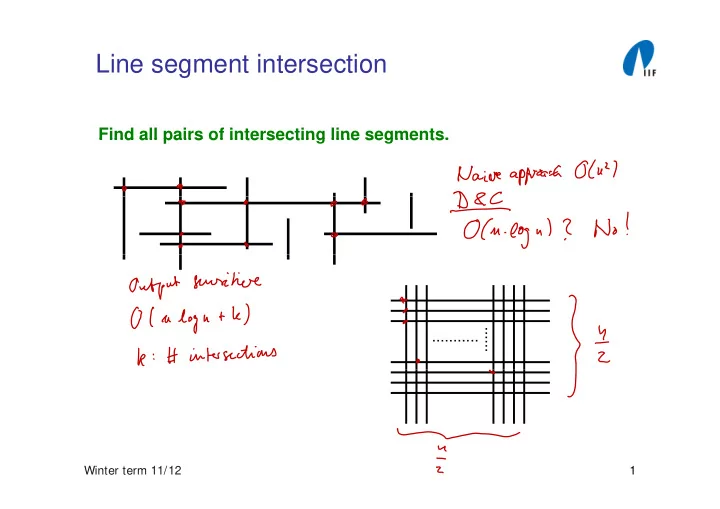

Line segment intersection Find all pairs of intersecting line segments. Find all pairs of intersecting line segments. ...... ........... Winter term 11/12 1
Line segment intersection Find all pairs of intersecting line segments. p g g A D E B C A. .A .D D. .E B. .B E. .C C. The representation of the horizontal line segments by their endpoints allows for a vertical partitioning of all objects. Winter term 11/12 2
ReportCuts Input: Set S of vertical line segments and endpoints of horizontal line segments. Output: All intersections of vertical line segments with horizontal Output: All intersections of vertical line segments with horizontal line segments, for which at least one endpoint is in S . 1. Divide if | S | > 1 then using vertical bisection line L divide S into equal size then using vertical bisection line L, divide S into equal size sets S 1 (to the left of L ) and S 2 (to the right of L ) else S contains no intersections Winter term 11/12 3
ReportCuts 1. Divide: 1 Divide: A A D D E S B B E C C S 1 S 2 2. Conquer: ReportCuts( S 1 ); ReportCuts( S 2 ) Winter term 11/12 4
ReportCuts 3. Merge: ??? Possible intersections of a horizontal line-segment h in S 1 Case 1: C 1 b both endpoints in S 1 h d i i S h S 1 S 2 Winter term 11/12 5
ReportCuts Case 2: only one endpoint of h in S 1 2 a) right endpoint in S 1 h S 1 S 2 Winter term 11/12 6
ReportCuts 2 b) left endpoint of h in S 1 right endpoint in S 2 h S 1 S 2 right endpoint not in S 2 h S S 1 S S 2 Winter term 11/12 7
Procedure: ReportCuts(S) 3. Merge: Return the intersections of vertical line segments in S 2 with horizontal line segments in S 1 , for which the left endpoint is in S 1 and the right endpoint is neither in S 1 nor in S 2 . and the right endpoint is neither in S 1 nor in S 2 . Proceed analogously for S 1 . S S 1 S S 2 Winter term 11/12 8
Implementation Set S L(S): y-coordinates of all left endpoints in S, for which the corresponding right endpoint is not in S corresponding right endpoint is not in S. R(S): y-coordinates of all right endpoints in S, for which the corresponding left endpoint is not in S. V(S) : y-intervals of all vertical line-segments in S. V(S) i t l f ll ti l li t i S Winter term 11/12 9
Base cases S contains only one element s. y Case 1: s = (x,y) is a left endpoint L(S) = {y} R(S) = ∅ V(S) = ∅ Case 2: s = (x y) is a right endpoint Case 2: s = (x,y) is a right endpoint L(S) = ∅ R(S) = {y} V(S) = ∅ Case 3: s = (x, y 1 , y 2 ) is a vertical line-segment L(S) = ∅ R(S) = ∅ V(S) = { [y 1 , y 2 ] } Winter term 11/12 10
Merge step Assume that L(S i ), R(S i ), V(S i ) are known for i = 1,2. S S = S 1 ∪ S 2 S S L(S) = ( ) R(S) = V(S) = L, R : ordered by increasing y-coordinates linked lists V : V : ordered by increasing lower endpoints ordered by increasing lower endpoints linked list Winter term 11/12 11
Output of the intersections V(S 2 ) V(S 2 ) h 3 h 2 h 1 L(S 1 ) Winter term 11/12 12
Running time Initially, the input (vertical line segments, left/right endpoints of horizontal line segments) has to be sorted and stored in an array. Divide-and-conquer: T(n) = 2T(n/2) + an + size of output T(1) = O(1) O(n log n + k) k = # intersections Winter term 11/12 13
Computation of a Voronoi diagram Input: Input: Set of sites Set of sites. Output: Partition of the plane into regions, each consisting of the points closer to one particular site than to any other site. Winter term 11/12 14
Definition of Voronoi diagrams P : Set of sites P : Set of sites H ( p | p’ ) = { x | x is closer to p than to p ’ } Voronoi region of p: ' I I ( ) ( | ' ) = VR p H p p \{ { p } } ∈ p p P p Winter term 11/12 15
Computation of a Voronoi Diagram Divide: Divide: Partition the set of sites into two equal sized sets Partition the set of sites into two equal sized sets. Conquer: Recursive computation of the two smaller Voronoi diagrams. Stopping condition: Stopping condition: The Voronoi diagram of a single site is the The Voronoi diagram of a single site is the whole plane. Merge: Connect the diagrams by adding new edges. Winter term 11/12 16
Computation of a Voronoi diagram Output: The complete Voronoi diagram. p g Running time: O(n log n), where n is the number of sites. R i ti O( l ) h i th b f it Winter term 11/12 17
Recommend
More recommend